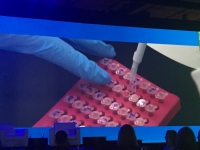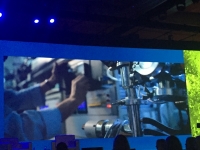Health
HOW PHARMA AND LIFESCIENCES ARE CHANGING THE WORLD
A NEW GLOBAL HEALTH ECONOMY

Pharmaceuticals and life sciences companies have a long, successful strategy of placing big bets on a few molecules, promoting them heavily and turning them into blockbusters. Pharma companies are becoming more proactive with large communities of patients and go beyond lip service in meeting the needs of a wide swath of consumers. Although the sale of products will always be a priority, companies concentrate on delivering positive results: health, well-being, and optimal management of illness among targeted populations.
However, commercial environments are getting harsher, pharmaceuticals and life sciences companies are also experiencing a wave of competing challenges. These include consolidation among providers, especially hospitals, intended to produce efficiency gains; the changing demands and expectations of patients, who seek a greater role in their own care; increasing cost pressures from payers leading to calls for pricing reform; and the declining autonomy of the individual physician as rule-based, protocol-driven care becomes ascendant. The resulting healthcare system focuses increasingly on paying for the value rather than the volume of medical care; in other words, it is a more consumer-facing industry.
Exploring cutting edge breakthroughs in this consumer-facing industry were exhilarating presentations about advancements in drug discovery, innovations in the biotech sector, diagnostics and therapeutic platform technologies which were buzzing throughout the San Diego Convention Center during the month of June elevating BIO2017 to a new height. Over 16,123 biotech leaders from around the globe, 41,400 partnering meetings provided attendees with unique perspectives on the emerging opportunities and complex challenges ahead for the industry.
HERE ARE SOME MAJOR GLOBAL PLAYERS TO WATCH:
USA -CALIFRONIA ““ SAN DIEGO
San Diego´s Biocom, the largest leader and advocate for California´s life science sector, founded in 1995 in San Diego, with offices in Los Angeles, Washington, D.C. and Tokyo, Biocom represents the second largest bio cluster in the US. The organization works on behalf of 900 members to drive public policy, build an enviable network of industry leaders, create access to capital and introduce cutting-edge STEM education programs. They create robust value-driven purchasing programs, work alongside industry, government, investors, academia and other stakeholders to develop new talent, cross-industry collaboration and a vibrant financing climate. Biocom´s vision 2020 is “for Southern California to become the world center in genomics, a powerhouse in digital health development, a pioneer in brain science breakthroughs and a creative force in delivering personalized medicine and molecular diagnostics attracting top researchers and companies to the region. We will be the epicenter for big data and analytics, accelerating understanding of the Science of Life.“ They are moving at a fast pace and are certainly on the right trajectory.
.A global leader in the field of genomics, Michael Nova, M.D., CEO of Pathway Genomics, who led the effort for the first sequencing of the human genome about fifteen ago. He and his team have been at the forefront of the technological push toward reforming healthcare systems to adopt the ethos of personalized medicine.
Since its founding in 2008, Pathway Genomics has concentrated its efforts on providing users with the most validated and personalized healthcare information delivered to any device. The company´s program with IBM Watson is the first of its kind to merge artificial intelligence and deep learning with precision medicine, applicable to both consumers and providers. Nova believes that medicine should allow patients to receive affordable, personalized and precise care. Pathway Genomics uses physician-ordered tests which include assays for diet and weight loss, circulating tumor DNA mutations (liquid biopsy), hereditary cancer and carrier screening, as well as metabolic response for many commonly prescribed medications. They also perform genetic testing innovations like Liquid Biopsy, a non-invasive, cancer monitoring and screening test.
At the most fundamental level, enabling customers to read and understand genetic variations is Illumina, global leader in genomics at the intersection of biology and technology. The company strive to make solutions increasingly simple, more accessible, and always reliable using innovative technologies to the analysis of genetic variation and function, making studies possible that were not even imaginable just a few years ago.
Another trailblazer par excellence, pioneer and game changer, is Australian native Mick Farrell, CEO of ResMed. He and his team change lives with award-winning medical devices and cutting-edge cloud-based software applications that better diagnose, treat and manage sleep apnea, chronic obstructive pulmonary disease (COPD) and other chronic diseases. San Diego based ResMed has become a global leader in connected care, with more than 3 million patients remotely monitored every day. They have a team of 5,000 employees who are committed to improving quality of life, reducing the impact of chronic disease, and saving healthcare costs in more than 100 countries creating by using tech-driven medical devices.
SWITZERLAND
Looking over the Pond, a small country which is as famous for its natural beauty, mountains and lakes, as it is for its chocolates, watches and pharmaceutical industry, has a lot to offer to potential investors. Switzerland has availability of high-quality scientists thanks to leading universities of applied sciences and financially sound and research-based pharmaceutical companies. “A third of Swiss exports come from the pharmaceutical industry, making this industry a large contributor to the Swiss national economy, says Daniel Bangser, FDI Director and Trade Commissioner of Switzerland to the US.“ Both, multinational corporations, such as Roche and Novartis, and small- and medium-sized pharmaceutical companies have excellent infrastructures and skilled employees at their disposal in Switzerland. The cooperation between large and small companies and the proximity to research institutions offer an ideal environment for research and innovation and form the basis for a highly-specialized production location.
In Switzerland, biotech and gene tech licensing applications are regulated by a single central authority (Federal Coordination Center for Biotechnology). This guarantees mini- mal bureaucracy and simple procedures. The Swiss Export Risk Insurance (SERV), an independent institution governed by public law, guarantees protection for high-risk export transactions. Swiss Biotech Association located in Basel, Zug, Zurich and Bern “Switzerland is home to a globally unique life science cluster, chemical and pharmaceutical firms such as Novartis, Roche, and Syngenta“ says Daniel Bangser continues.“ Free trade agreements with the EU and 38 other countries, including China, guarantee access to the most important export markets. 192.5 million euros are saved yearly through pharmaceutical and chemical exports to Germany, France, Austria and the United Kingdom alone. Furthermore, Switzerland has the third most dense network of bilateral investment treaties (after Germany and China)“.
IRELAND
Also vowing pharmaceutical companies with tempting incentives and greener pastures, was IDA Ireland. “Following the Brexit vote, IDA Ireland, the country´s inward investment promotion agency, invited members to discuss what the UK´s decision to leave the EU would mean for business. Even before the decree absolute was signed, the Irish Department of Health under Minister Simon Harris had put together a team to prepare Ireland´s bid. It contended that Ireland, Dublin in particular, made the most sense “ says Mike Storan, Vice President of Life Sciences, IDA Ireland Investment and Development agency. “Dublin is a growing multi-cultural hub where nine of the top 10 global pharmaceutical companies have a presence; it is the largest net exporter of pharmaceuticals in the EU, and the 7th largest exporter of medicines and pharmaceutical products in the world. Ireland has 33 FDA-approved pharma, and biopharma plants and a $100 million research and trading center: the National Institute for Bioprocessing Research and training (NIBRT); and, it´s an English speaking population“.
For US biotech companies, the EMA is the first port of call in their efforts to access the EU which accounts for a quarter of all global pharmaceutical sales. “The biotech industry needs to maintain swift trial approval processes as EMA prepares to move out of the UK“ says Storan. The European Medicines Agency (EMA) is a decentralized agency of the European Union that evaluates the safety of medical products for consumers in the 500 million-strong European Single Market. It has become invaluable in increasing the efficiency of drug regulation across the EU, giving Europeans access to new treatments and new medications quickly. The need for a smooth EMA transition is critical, especially for US biotechs, from both a financial and staffing point of view. The sooner a new hub is confirmed, the sooner US firms ““ most of whom have enjoyed successful collaborations over the last few decades ““ can co-locate and continue to grow their presence and their market across Europe.
THAILAND
Thailand presented as one of the most robust biotech industries in the ASEAN market, which is underpinned by incentives and government support of the Life Sciences sector. It boasts over 200 biotech firms with a combined market value of over $2 billion and has led on ground-breaking research ranging from the nutritional enhancement of core crops, to diagnosing viruses in shrimp, and researching mosquito borne illnesses.
“The Thai government is excited Thailand´s academia, research organizations and the private sector to showcase our country´s extensive Life Science assets and expertise,“ said Ms. Ajarin Pattanapanchai, Deputy Secretary General.
Supported by the BOI, biotechnology companies investing in Thailand are granted an 8-year corporate income tax exemption regardless of location and are not subject to a corporate income tax exemption cap. They are also eligible to receive an exemption of import duties on machinery and those that locate in science and technology parks can receive an additional five-year 50% corporate income tax reduction on net profits. Non-tax incentives are also available such as an expedited visa program to enable foreign experts and skilled technicians to receive work permits.
AUSTRALIA -PERTH
Perth, San Diego´s Sister City, which recently celebrated a 30 year partnership drives sustainability and growth development of the life science industry Down Under. Showcasing some interesting opportunities for US companies was the “Linear“ company, based in the heart of Perth. Linear was conceived as a focal point for Australian clinical and medical research, bringing world-first clinical trials to Western Australia and making innovative therapies available to the WA community. Early space clinical trials are carried out here very speedy, 4 to 6 weeks, 3 to 6 months for phase 1 trials. From early-phase to late-phase, clinical trial services range from first-in-human and first-in-patient studies through to Phase 4 trials.
“There´s a host of reasons why US sponsors are turning to Linear and choose Perth, Australia“ says Jayden Rogers, VP Global Partnering. “The Australian government supports clinical research with a 20 billion federal initiative, generous tax incentives, fast-track trial start-ups, with no IND required. Linear offers a14,000+ volunteer database and global collaborator network to tap into.“ Plus they offer a multidisciplinary team that adds clinical, practical and financial value at every stage of your therapy´s concept-to-commercialization journey. “We would love to work with San Diego companies and welcome them to Perth “ says Jayden.
Our world is changing at an unprecedented pace and “patient first“ has become a rallying cry in the pharma industry. In general, the most successful firms seem to be moving away from a traditional, top-down model of product promotion and toward a flexible, interactive approach that gives patients better tools and more focused information about the drugs they are taking and how to manage their conditions. No doubt, the next big medical breakthroughs are still out there and they may start in a small business with a big idea.








